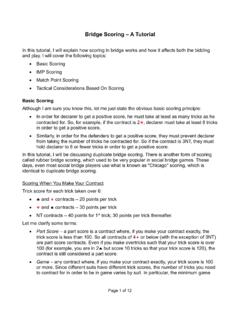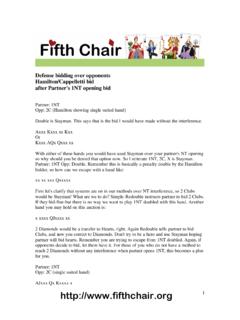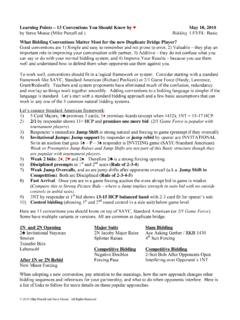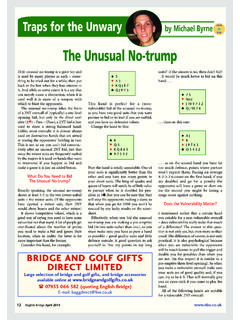Transcription of Introduction To The 2 Over 1 Game Force System – Part 1
1 Introduction To The 2 over 1 Game Force System Part 1 This is the first of two articles introducing the basic principles of the 2 over 1 Game Force bidding System . In this article, I will discuss auctions when responder wishes to Force to game. In the second article, I will discuss auctions when responder has less than game forcing this article, I will also describe the Fourth Suit Forcing convention. Although not strictly part of the 2 over 1 System , it shares some of the same I refer to Standard American in these articles, this is the same System as SAYC. SAYC stands for Standard American Yellow Card , so named because the ACBL has developed a yellow convention card which describes their recommended version of Standard both articles, I assume no interference by the opponents.
2 When the opponents interfere, 2 over 1 and Standard American are PrinciplesThe 2 over 1 System is actually very similar to the Standard American System . Auctions beginning with one of a minor or 1NT are identical. Many auctions beginning with one of a major are also only real difference between the two systems is when responder bids at the 2 level over an opening bid of 1H or 1S. In the 2 over 1 Game Force System , this establishes a game forcing auction. The partnership may not pass until a game contract is reached. This is the main principle upon which the System is only problem that occurs is when responder has an invitational but not game forcing hand (around 10 or 11 points). In Standard American, responder can bid at the 2 level to show 10 points or more.
3 However, in 2 over 1, this option is not available, because a hand with 10 or 11 points is invitational, not game forcing. In order to handle this problem, the 2 over 1 System modifies how the 1NT response works over one of a major. In Standard American, 1NT shows 6-9 (or 6-10) and can be passed. In 2 over 1, a 1NT bid is a one round Force ; opener may not pass. This treatment is known as the Forcing NT . The next article will discuss auctions in which responder bids a forcing , to summarize, there are only 2 differences between Standard American and 2 over 1 opener opens one of a major, and responder bids at the 2 level, that establishes a game forcing auction. The partnership may not pass out the auction below opener opens one of a major, and responder bids 1N, that is a one round Force .
4 Opener may not does one determine if you have a game forcing hand? I use a very simple method that I find effective. I use the rule of 20 to determine if I have an opening bid in all 4 seats. (Briefly, the rule of 20 states you have an opening bid if the sum of your high card points plus the number of cards in your 2 longest suits is 20 or more.) Therefore, if partner opens, and I have a hand that meets the rule of 20, I have enough to make a game forcing bid. Note that I will also bid game if I have 5 card support, even with fewer high card points,, but will jump directly to 4 if I do not have an opening hand. Note that once you pass, if partner opens one of a major, a 2 level bid is no longer forcing, but simply reverts back to the same meaning as Standard American, showing a good suit with at least 10 points.
5 For simplicity, I play new suits are still forcing by responder, but that is a matter of partnership your partner opens 1H. What do you respond with each of these hands: Axx Kxx AJxxx xxBid 2D, forcing to game. Unless partner shows a very strong hand, you will likely end up in 4 hearts. Axx Kx AJxxx xxxThis is still a 2D bid. However, you are not sure what the final contract will be, although 3N is quite likely. Axxx Kx AJxx xxxBid 1S. You are not obligated to bid 2 over 1 if you have a game forcing hand with spades. New suit by responder is still forcing for one round. Axxx Kx AJxxx xxBid 2D. over partner's rebid, bid spades. This shows 5+ diamonds and 4 spades. Even playing Standard American, you should bid 2D over 1H. Qxxx Kx AJxxx xxBid 1S. Unlike the previous hand, you only have an invitational hand, so you cannot bid 2D, which is a game Force .
6 Qxx Kx AQxxx xxxBid 1N. You cannot bid 2D, as that is game forcing, and you only have an invitational hand. Axx Kxxx AJxx xxBid 2N. This is Jacoby 2N, showing a game forcing hand with 4 card heart support. Jacoby 2N is still a valid bid in the 2 over 1 System . Ax Kxxx AJxxx xxI would still bid 2N, to show 4 card heart support. However, 2D is a reasonable VariationsThe principles I described in the previous section are how I play 2 over 1. I think the approach described is both the easiest and most effective way to play the System . However, there are a couple of variations which I will describe but do not first variation is a response of 2C over 1D. The modern tendency is to also play that as a game Force . The problem with that approach is that the forcing 1N bid is not available over 1D, so you have a problem with an invitational hand with a good club suit.
7 I personally prefer to play that auction has the same meaning as it does in Standard American, showing at least 10 points but not game forcing. However, if you want to play that as a game forcing auction, and bid 1N or 2N with the invitational hand with clubs, that is certainly second variation is if responder bids a suit at the 2 level and then repeats it at the 3 level. Some partnerships play that eliminates the game forcing auction. However, my feeling is, if you play that way, why not just play Standard American and not bother to play 2 over 1 Game Force ? If you play 2 over 1 is an absolute game Force , as I recommend, that sort of auction can be used to show a really good suit and some slam interest. If you believe in 2 over 1 Game Force ,then play it; if you do not, then don't play it.
8 The third variation is whether or not a reverse by opener shows extra values. In Standard American, a reverse by opener after a 2 level bid by responder establishes a game forcing auction, since opener is showing 16+ and responder is showing 10+. However, in 2 over 1, that is not necessary, since you are already in a game forcing auction. I personally play a reverse by opener still shows extra values. My reasoning is that playing reverses as showing extra values makes it easier to find slam, and I see no downside to playing it this way. However, many experts play that once responder bids 2 over 1, a reverse by opener is simply a further description of opener's hand, and does not promise extra values. There is no universal agreement about this, so you need to establish a partnership agreement about ArrivalAnother important principle of 2 over 1 is Fast Arrival.
9 The basic idea is that once a game Force is established, if responder jumps to game right away, he has no interest in exploring further for slam. If responder goes more slowly, he has a better hand and may be exploring for slam. For example, the auction 1H-P-2C-P-2D-P-4H is weaker than the auction , once you establish a game forcing auction, if you arrive fast to game by jumping there, that shows a less strong hand than if you take your time in bidding game. This is the opposite of Standard idea is that you want to leave as much bidding room as possible to explore for slam. If you are pretty sure you only have game, there is no point in dilly dallying; just bid it. However, if you want to explore for slam, you can leave lots of bidding room to help you decide if slam is your partner opens 1H, you respond 2C, and partner bids 2D.
10 What do you bid with each of these hands: Axx Kxx xx AJxxxBid 4H, using the principle of fast arrival. Slam is unlikely, as partner made a minimum rebid. Axx KJx xx AKJxxBid 2H. With 16 HCP, you have more than a minimum game forcing bid, so bid 2H indicating that you are interested in exploring for slam. Ax KJxx xx AKJxxI would bid 3H, but you need to have an agreement as to what this auction means. I play it shows 16+ HCP, a good suit, and 4 card support in hearts. Ax Kx xxx AKQxxxBid 3C. This shows a strong club suit, game forcing values, and possible interest in slam. AJx Kx xxx AQxxxBid 3N. You have a fairly minimum game forcing hand, and are really not interested in exploring any Suit ForcingFourth suit forcing (4sf) is a convention most experts play as a way of establishing a game forcing auction while keeping the bidding at a lower level.










